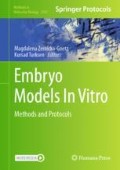Abstract
The microfluidic amniotic sac embryoid (μPASE) is a human pluripotent stem cell (hPSC)-derived multicellular human embryo-like structure with molecular and morphological features resembling the progressive development of the early post-implantation human embryonic sac. The microfluidic device is specifically designed to control the formation of hPSC clusters and expose the clusters to different morphogen environments, allowing the development of μPASEs in a highly controllable, reproducible, and scalable fashion. The μPASE model displays human embryonic developmental landmarks such as lumenogenesis of the epiblast, amniotic cavity formation, and the specification of primordial germ cells and gastrulating cells (or mesendoderm cells). Here, we provide detailed instructions needed to reproduce μPASEs, including the immunofluorescence staining and cell retrieval protocols for characterizing μPASEs obtained under different experimental conditions.
Access this chapter
Tax calculation will be finalised at checkout
Purchases are for personal use only
References
Bianco-Miotto T, Craig JM, Gasser YP, van Dijk SJ, Ozanne SE (2017) Epigenetics and DOHaD: from basics to birth and beyond. J Dev Orig Health Dis 8(5):513–519
Koot Y, Teklenburg G, Salker M, Brosens J, Macklon N (2012) Molecular aspects of implantation failure. Biochim Biophys Acta (BBA) 1822(12):1943–1950
Fu J, Warmflash A, Lutolf MP (2021) Stem-cell-based embryo models for fundamental research and translation. Nat Mater 20(2):132–144
Rossant J, Tam PP (2017) New insights into early human development: lessons for stem cell derivation and differentiation. Cell Stem Cell 20(1):18–28
Rossant J (2015) Mouse and human blastocyst-derived stem cells: vive les differences. Development 142(1):9–12
Tyser RC, Mahammadov E, Nakanoh S, Vallier L, Scialdone A, Srinivas S (2021) Single-cell transcriptomic characterization of a gastrulating human embryo. Nature 600(7888):285–289
Xiang L, Yin Y, Zheng Y, Ma Y, Li Y, Zhao Z, Guo J, Ai Z, Niu Y, Duan K (2020) A developmental landscape of 3D-cultured human pre-gastrulation embryos. Nature 577(7791):537–542
Shahbazi MN, Jedrusik A, Vuoristo S, Recher G, Hupalowska A, Bolton V, Fogarty NM, Campbell A, Devito LG, Ilic D (2016) Self-organization of the human embryo in the absence of maternal tissues. Nat Cell Biol 18(6):700–708
Deglincerti A, Croft GF, Pietila LN, Zernicka-Goetz M, Siggia ED, Brivanlou AH (2016) Self-organization of the in vitro attached human embryo. Nature 533(7602):251–254
Rossant J, Tam PP (2018) Exploring early human embryo development. Science 360(6393):1075–1076
Hyun I, Wilkerson A, Johnston J (2016) Embryology policy: revisit the 14-day rule. Nature 533(7602):169–171
Williams K, Johnson MH (2020) Adapting the 14-day rule for embryo research to encompass evolving technologies. Reprod Biomed Soc Online 10:1–9
Hurlbut JB, Hyun I, Levine AD, Lovell-Badge R, Lunshof JE, Matthews KR, Mills P, Murdoch A, Pera MF, Scott CT (2017) Revisiting the Warnock rule. Nat Biotechnol 35(11):1029–1042
Zheng Y, Xue X, Resto-Irizarry A, Li Z, Shao Y, Zheng Y, Zhao G, Fu J (2019) Dorsal-ventral patterned neural cyst from human pluripotent stem cells in a neurogenic niche. Sci Adv 5(12):eaax5933
Haremaki T, Metzger JJ, Rito T, Ozair MZ, Etoc F, Brivanlou AH (2019) Self-organizing neuruloids model developmental aspects of Huntington’s disease in the ectodermal compartment. Nat Biotechnol 37(10):1198–1208
Xue X, Sun Y, Resto-Irizarry AM, Yuan Y, Aw Yong KM, Zheng Y, Weng S, Shao Y, Chai Y, Studer L (2018) Mechanics-guided embryonic patterning of neuroectoderm tissue from human pluripotent stem cells. Nat Mater 17(7):633–641
Warmflash A, Sorre B, Etoc F, Siggia ED, Brivanlou AH (2014) A method to recapitulate early embryonic spatial patterning in human embryonic stem cells. Nat Methods 11(8):847–854
Moris N, Anlas K, van den Brink SC, Alemany A, Schröder J, Ghimire S, Balayo T, van Oudenaarden A, Martinez Arias A (2020) An in vitro model of early anteroposterior organization during human development. Nature 582(7812):410–415
Shao Y, Taniguchi K, Townshend RF, Miki T, Gumucio DL, Fu J (2017) A pluripotent stem cell-based model for post-implantation human amniotic sac development. Nat Commun 8(1):1–15
Shao Y, Taniguchi K, Gurdziel K, Townshend RF, Xue X, Yong KMA, Sang J, Spence JR, Gumucio DL, Fu J (2017) Self-organized amniogenesis by human pluripotent stem cells in a biomimetic implantation-like niche. Nat Mater 16(4):419–425
Zheng Y, Yan RZ, Sun S, Kobayashi M, Xiang L, Yang R, Goedel A, Kang Y, Xue X, Esfahani SN (2022) Single-cell analysis of embryoids reveals lineage diversification roadmaps of early human development. Cell Stem Cell 29 (9):1402–1419.e1408
Zheng Y, Xue X, Shao Y, Wang S, Esfahani SN, Li Z, Muncie JM, Lakins JN, Weaver VM, Gumucio DL (2019) Controlled modelling of human epiblast and amnion development using stem cells. Nature 573(7774):421–425
Zheng Y, Shao Y, Fu J (2021) A microfluidics-based stem cell model of early post-implantation human development. Nat Protoc 16(1):309–326
Acknowledgments
This work was supported by the National Institutes of Health (R21 HD105192 and R21 HD109635) and the Department of Biomedical and Chemical Engineering at Syracuse University.
Conflicts of Interest
Two patents related to this work have been filed (US20190321415/WO2018106997 by J. Fu, Y. Zheng, and S.N. Esfahani; US2020049721/PCT/US20/49721 by J. Fu and Y. Zheng).
Author information
Authors and Affiliations
Editor information
Editors and Affiliations
Rights and permissions
Copyright information
© 2023 Springer Science+Business Media, LLC
About this protocol
Cite this protocol
Zheng, Y. (2023). Stem Cell-Derived Microfluidic Amniotic Sac Embryoid (μPASE). In: Zernicka-Goetz, M., Turksen, K. (eds) Embryo Models In Vitro. Methods in Molecular Biology, vol 2767. Humana, New York, NY. https://doi.org/10.1007/7651_2022_470
Download citation
DOI: https://doi.org/10.1007/7651_2022_470
Published:
Publisher Name: Humana, New York, NY
Print ISBN: 978-1-0716-3685-5
Online ISBN: 978-1-0716-3686-2
eBook Packages: Springer Protocols

